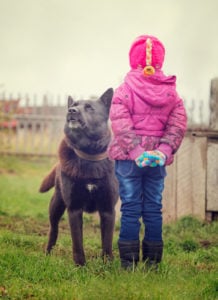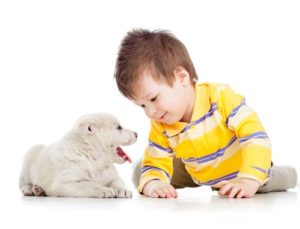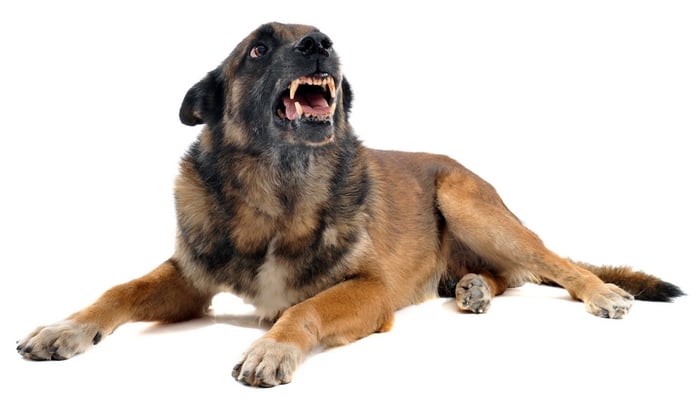
One of the most frequent behavioral reasons owners take their dogs to the veterinarian or even back to the shelter is aggression. Considering the damage to property and danger to people that aggression in dogs may present, it is not surprising that owners often seek help with this problem.
Table of Contents
Yesterday, we wrote about popular fighting dogs, where canine aggression is an asset. Today, I wanted to delve deeper into the science behind aggression in dogs, take a look at its causes, and examine the consequences of having an aggressive dog.
Lack of proper training is why we euthanize dogs.
It has been estimated that approximately 4.3 million people are bitten by dogs every year (1), and 2 million dogs are euthanized (2) in animal shelters annually.
 According to research, dog aggression is one of the main reasons for such a high number and why many pet owners are forced to relinquish their dogs.
According to research, dog aggression is one of the main reasons for such a high number and why many pet owners are forced to relinquish their dogs.
One study on this subject (3) concluded that the best way to avoid euthanized animals is to encourage pet owners to take dogs to obedience training classes and regular vet visits.
According to experts, dog aggression is the most urgent behavioral issue pet owners and veterinarians must deal with (4) for obvious reasons.
When it comes to dog's behavioral problems, in order to minimize the risks associated with an aggressive dog, it's of utmost importance for owners to understand what exactly aggression in dogs means, its causes, and ways to avoid and modify aggressive behavior.
That is the purpose of this article – to provide you with an evidence-based look at canine aggression and give pet owners a more in-depth look at this common behavioral problem.
We're going to discuss the four main types of aggression in dogs and the triggers for each one of them. However, while this information is beneficial to keep in mind, you need to seek the help of a professional dog trainer when dealing with aggression in dogs. If this problem is not handled properly, the behavior could become more severe (5).
Moreover, if you're not properly trained to deal with a dog's aggression, you risk hurting yourself and the dog, too. Look for a trainer that specializes in working with aggressive dogs, and find one that deals with your pet's specific type of aggression, if possible.
READ: 15 Facts about Fear Aggression in Dogs
Aggression in Dogs: What Does Science Says?
The four types of aggression in dogs
Before delving into the possible causes of aggression in dogs, we must first review the four types of aggression that dogs exhibit most often and as defined by science (6).
The four known canine aggression types are:
- Aggression directed toward the owner
- Aggression toward children
- Aggression directed toward strangers
- Aggression toward other dogs
A dog may exhibit one of these types of aggression or a combination of the four (6).

Although personally, an owner may be the most concerned about aggression directed toward oneself, in a way, the most dangerous forms of canine aggression are stranger-directed and child-directed.
Stranger-directed dog aggression (7) is dangerous because a stranger’s behavior is impossible to predict, and they may go as far as suing the owner for any damage incurred.
Child-directed dog aggression is especially dangerous (8), because children behave erratically and are smaller and weaker than adults or dogs. Therefore, they are more likely to be seriously injured as a result of aggressive dog behavior.
RECOMMENDED: How To Train A Dog To Behave Around Children
Some breeds are more aggressive than others
While aggression is common in all dogs to an extent, some breeds are more predisposed to be extremely aggressive by nature (9, 10). For example, the rare breed of Jindo dog is known to be aggressive towards strangers because it's in their genes (11). The same has been observed with Shiba Inu (12) and several other dog breeds.
Experts have noticed that more aggressive dog breeds are those that are closer to wolves in their genetic makeup. For example, the above-mentioned Jindo dog and Shiba Inu are some of the most stubborn dogs that are difficult to train, and it all comes down to them being genetically closer to a wolf than the majority of modern dogs (12, 13, 14).
This means that you should know your dog very well in order to avoid behavioral problems going unnoticed until it's too late. The best way to learn about your dog's exact gene pool and ancestry is through dog DNA tests, which are becoming very popular.
Reactive dogs are more likely to be aggressive
Reactivity to stimuli, or a dog’s physical reaction to sudden movements or sounds in the home, has been positively correlated (4, 15, 16) with all four types of aggression in dogs.
In other words, dogs that react strongly to sudden stimuli are more likely to exhibit aggressive behavior toward most people and dogs with whom they come in contact, as has been observed in many cases.
 Thus, if you notice your dog is quite jumpy when the phone rings or when you move abruptly, you should be aware that he is more likely to behave aggressively.
Thus, if you notice your dog is quite jumpy when the phone rings or when you move abruptly, you should be aware that he is more likely to behave aggressively.
To put it further into context, if you are walking your dog and you know he's jumpy, be mindful when he is near strangers, other dogs, and especially children. It goes without saying that it's also a good idea to consult with a professional dog trainer about this.
This is especially important when it comes to kids. Children naturally tend to move quickly, unpredictably, and be noisy. A dog that has a high reactivity to stimuli may pose a real threat to kids. Therefore, to be safe, owners with highly reactive dogs should keep a safe distance between their dogs and children, especially unfamiliar children.
Owners with highly reactive dogs may also train their dogs to be less reactive to stimuli by purposely exposing them to sudden sounds and movement in a safe environment, where the dog can learn that these stimuli do not present danger and, therefore, do not warrant aggression.
WATCH THIS: How to Teach Kids to Behave Around Dogs
There's a reason why vets and trainers stress the importance of socializing dogs, especially at an early age. Proper socialization can prevent or reduce many serious behavioral problems in dogs, one of them being all types of canine aggression.
Studies observed that sociability with humans, or how comfortable a dog is interacting with humans, correlates negatively with stranger-directed and child-directed aggression (15, 17). This means that the less comfortable a dog is interacting with humans, the more likely he is to behave aggressively toward strangers and children.
This presents a real problem because, as stated earlier, stranger-directed and child-directed aggression has the potential to cause the most problems. To a certain extent, aggressive behavior is an instinctual defense mechanism for a dog, so it is not surprising that dogs who are uncomfortable with humans would behave aggressively toward strangers and children.
If you notice your dog is uncomfortable with people, it would be smart to keep a safe distance between him and strangers and children – at least until you are able to train him to be more comfortable with people. Gently exposing your dog to new people in a safe and controlled environment may eventually help him become more sociable with humans.
Why a dog in pain is always more likely to bite
 Aside from stimuli and genetics, another common and most predictable reason for aggression in dogs is when they experience pain (18).
Aside from stimuli and genetics, another common and most predictable reason for aggression in dogs is when they experience pain (18).
When dogs are in pain, they are more likely to behave aggressively, especially toward children (19). Specifically, dogs in pain are more likely to bite children.
There's also some evidence that irritability contributes to a dog's aggressive behavior, and medical conditions, diseases, and pain have been linked to irritability in dogs (20, 21), which ultimately increases the chance of a dog exhibiting aggressive behavior.
As stated earlier, dog bites are particularly treacherous for children because they are smaller and weaker than adults. To be safe, if you know your dog is in pain already or there's a high probability of causing pain to a dog, keep him away from children.
Even if your dog is not currently in pain, be aware that some children are not used to being around dogs and may mistakenly hit a dog or cause a dog pain. Make sure you're aware of all the safety advice for interaction between dogs and kids and that you show your children how to interact with your dog without hurting him.
Resource guarding may cause aggression
As stated earlier, certain aggressive behavior in dogs is instinctual, which is impacted by their genes and is most common in wolf-like dogs and dogs closely related to wolves.
This is especially true when a dog behaves aggressively in order to guard his resources. As it has been explored in the article on dog's resource guarding, a canine does not have language to communicate to someone that he owns a certain piece of food or dog toy, therefore, aggression is one of his only ways to protect his belongings.
In fact, it has been found (4) that dogs who are guarding their resources are more likely to bite children, especially those who are unfamiliar with the dog.
To avoid this, when kids are going to be near your dog, make sure you take the time to explain to those children that they should not try to take the dog's food or toys.
RELATED: Dog Repellent Sprays for Correcting Behavior
How to deal with aggression in dogs
 Canine aggression is still not fully understood by science or dog trainers, but there are some proposed ways that have been shown to decrease aggression in dogs.
Canine aggression is still not fully understood by science or dog trainers, but there are some proposed ways that have been shown to decrease aggression in dogs.
The first step is to understand your own canine's aggression and the causes of it.
For example, studies observed that male dogs are more likely to bite due to aggression (22), with research showing that in 75% of dog bite cases, it's always the male dog.
In general, to avoid having kids, strangers, and other pets bitten by your dogs, experts recommend avoiding specific dog breeds altogether and ensuring that the dog goes through obedience training, which seems the most effective solution (23, 24).
Another way to decrease aggression in dogs and the chance of bites is through spaying and neutering them, according to some studies (22). However, not all types of aggression can be eliminated with this procedure, as there's some evidence (25) that even neutered dogs will exhibit resource guarding and territorial aggression.
If you have kids and are thinking about adopting a dog, choose among the kid-friendly dog breeds. Make sure your children know how to behave around dogs, too.
Finally, as I've mentioned above, socialization is very important, and so is finding causes of aggression in your specific dog (e.g., stimuli in the environment, causes of pain, unruly children, etc.). These are effective tools in dealing with your dog's aggressive behavior.
Take home message
Although aggression in dogs can be seen as a defense mechanism, it can result in damage to property or danger to people, especially kids. Therefore, dog owners need to be aware of specific causes of canine aggression and remove them, if possible.
While aggression in dogs is not fully understood, there is plenty of evidence pointing at potential causes, from pain, stimuli, and lack of socialization to some dogs and the male gender being more genetically predisposed to aggressive behavior.
If your dog is highly reactive to stimuli or uncomfortable with humans, experts recommend that you engage your dog in obedience training and train him to be more comfortable with other pets and people, and children in particular.
References
READ NEXT: 10 Psychological Dog Training Tricks













